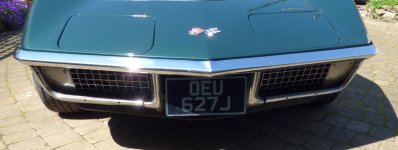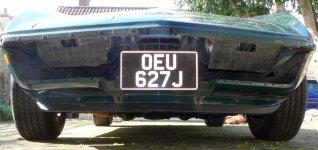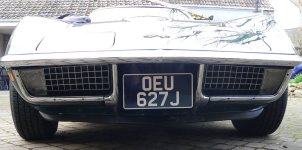antijam
CCCUK Member
While waiting for the front end chrome of my ’71 to come back from the platers I’ve spent many happy days trying to sort out what started as an intermittent misfire on one or two cylinders but developed into chronic misfire on all of them. Misfires are usually due to electrics or fuel, more often electrics, right?
So, starting at the sparking end I remove the plugs. They’re quite wet and sooty although whether this is a symptom of the misfire or its cause is not obvious. I clean them up and check their resistance and that of the HT leads and both are within spec. Moving back to the distributor I remove the cap and check for tracking. The cap is relatively new and shows no signs of breakdown anywhere. Remove the Rotor and check the points. They’re slightly worn but after cleaning they seem OK. However, I decide to get a ‘tune up’ kit and replace the rotor, points and condenser. At the same time I fit a new coil and replace the HT ignition wires with larger diameter low resistance cable. With everything back together I fire up and……no change, misfire still there.
So, it’s onto the fuel system. I have an inline fuel filter fitted between the pump and the carb and I replace this….
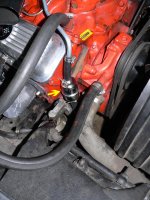
… then remove and strip down the carb – an original Rochester Quadrajet. With the carb stripped I take the opportunity to downsize my already three sizes over stock primary jets (to compensate for headers and a free flow exhaust) one size since I know the car has been running rich since I recently cured a vacuum leak. While dismantling the carb I notice that the needle valve return clip has migrated from the centre of the float arm into one of the slotted holes. Could this perhaps have been jamming the needle and preventing it shutting off fuel as the float rises, thereby flooding the carb and giving rise to my problem? I’m not convinced that the clip is strictly necessary since fuel pressure should lift the needle as the float drops. Still, I re-assemble the carb making sure that the clip is hanging from the centre of the float arm and not in one of the holes.
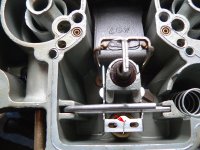
With the carb back together and refitted to the car and after a careful check of all fuel and electrical connections, I fire her up….no change, misfire still there.
OK, backtrack to the last thing I changed on the car before the misfire first occurred. This it turns out was the spark plugs. I’d replaced the stock AC Delco R44TS plugs with Accel 576S ‘shorties’ This was to make connection of the plug caps easier since I have headers fitted, reducing the gap between exhaust pipe and spark plug. This swap wasn’t essential since I could fit the plug caps to the standard plugs but the ‘shorties’ made it easier. Although for several weeks after fitting these plugs they had performed without problem and their resistance still checked out fine, I wondered if somehow they had degraded and were actually the cause of the misfire?
So, laboriously swap the plugs back to the AC Delco’s and with fingers crossed, fire her up again. Success! Motor runs without misfire although a bit lumpily since I haven’t set the dwell since fitting the new points. Correct this and she settles down to a smooth idle and with no misfire through the rev range.

I’ve found reviews of Accel shorty plugs on several small block forums. Some people seem to be running them without problem while many others say they’re the cause of all sorts of problems – including misfires. Looks like I must have been one of the latter.
If I’d left well alone and lived with the restricted access to stock plugs I’d never have had the problem. If it ain’t broke, don’t fix it! Still, I now have my chrome back and I’ve repainted the grilles so I have another job to keep me out of mischief.
So, starting at the sparking end I remove the plugs. They’re quite wet and sooty although whether this is a symptom of the misfire or its cause is not obvious. I clean them up and check their resistance and that of the HT leads and both are within spec. Moving back to the distributor I remove the cap and check for tracking. The cap is relatively new and shows no signs of breakdown anywhere. Remove the Rotor and check the points. They’re slightly worn but after cleaning they seem OK. However, I decide to get a ‘tune up’ kit and replace the rotor, points and condenser. At the same time I fit a new coil and replace the HT ignition wires with larger diameter low resistance cable. With everything back together I fire up and……no change, misfire still there.
So, it’s onto the fuel system. I have an inline fuel filter fitted between the pump and the carb and I replace this….

… then remove and strip down the carb – an original Rochester Quadrajet. With the carb stripped I take the opportunity to downsize my already three sizes over stock primary jets (to compensate for headers and a free flow exhaust) one size since I know the car has been running rich since I recently cured a vacuum leak. While dismantling the carb I notice that the needle valve return clip has migrated from the centre of the float arm into one of the slotted holes. Could this perhaps have been jamming the needle and preventing it shutting off fuel as the float rises, thereby flooding the carb and giving rise to my problem? I’m not convinced that the clip is strictly necessary since fuel pressure should lift the needle as the float drops. Still, I re-assemble the carb making sure that the clip is hanging from the centre of the float arm and not in one of the holes.

With the carb back together and refitted to the car and after a careful check of all fuel and electrical connections, I fire her up….no change, misfire still there.
OK, backtrack to the last thing I changed on the car before the misfire first occurred. This it turns out was the spark plugs. I’d replaced the stock AC Delco R44TS plugs with Accel 576S ‘shorties’ This was to make connection of the plug caps easier since I have headers fitted, reducing the gap between exhaust pipe and spark plug. This swap wasn’t essential since I could fit the plug caps to the standard plugs but the ‘shorties’ made it easier. Although for several weeks after fitting these plugs they had performed without problem and their resistance still checked out fine, I wondered if somehow they had degraded and were actually the cause of the misfire?
So, laboriously swap the plugs back to the AC Delco’s and with fingers crossed, fire her up again. Success! Motor runs without misfire although a bit lumpily since I haven’t set the dwell since fitting the new points. Correct this and she settles down to a smooth idle and with no misfire through the rev range.
I’ve found reviews of Accel shorty plugs on several small block forums. Some people seem to be running them without problem while many others say they’re the cause of all sorts of problems – including misfires. Looks like I must have been one of the latter.
If I’d left well alone and lived with the restricted access to stock plugs I’d never have had the problem. If it ain’t broke, don’t fix it! Still, I now have my chrome back and I’ve repainted the grilles so I have another job to keep me out of mischief.
Last edited:

